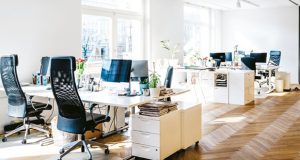Our new understanding of the risks of sedentary working is transforming the office, says Mark Eltringham, as furniture designers and FMs seek to keep people healthy and active
One of the most talked-about office design trends right now is activity-based working. The principle itself is pretty simple: work that is based on a range of specific activities which people carry out in an appropriate space within the office. The workplace itself is designed to provide the choice of spaces people need, for focused work, collaborative work, private meetings, videoconferencing, relaxation and so on.
It is often seen as something of a radical departure from what we might still consider mainstream office design. And yet, in a historical context, it is activity-based working that is the norm.
Most of us are introduced to the idea at an early age. It is school and higher education that provide the archetypes of a building for learning, sharing, working quietly, interacting and taking breaks. Students, lecturers and teachers alike move constantly to the best space for what they need to do: classrooms, labs, break areas, gyms, computer rooms, workshops, seminar rooms, media spaces, assembly halls and so on, each fitted out with the right furniture and resources. Schools embody activity-based working.
Perhaps the majority of modern offices now incorporate this kind of thinking to a greater or lesser degree. From the point of view of office furniture, the vast increase in the use of shared space has transformed the market. Where once the primary furniture elements were desks – usually allocated to an individual, they are now more likely to be chairs – usually specified in shared spaces.
The cost to the UK of poor ergonomics tends to be dominated by the headline figures for musculoskeletal disorders (MSDs). According to the latest HSE statistics, 507,000 workers suffered from work-related MSDs in 2016/17, and the UK lost 8.9 million working days to them.
Yet this is only half the equation. There is also an opportunity cost when we don’t create the best possible working environment for people. It’s worth investing a little extra time and resource in focusing on benefits, because the right working culture and surroundings make it possible not only to reduce the costs associated with poor ergonomics, but also improve wellbeing and productivity.
 These issues have become more important as a result of the profound changes in the technology we use and the way we work. So, while current ergonomic legislation such as the Display Screen Equipment Regulations is still focused almost entirely on the way people work with a PC, more and more time in the office is spent working on other devices and in new ways.
These issues have become more important as a result of the profound changes in the technology we use and the way we work. So, while current ergonomic legislation such as the Display Screen Equipment Regulations is still focused almost entirely on the way people work with a PC, more and more time in the office is spent working on other devices and in new ways.
In many respects this is a positive development because we know that the ability to move freely is good for us. A well-designed chair will not only allow people to move but will encourage them to adopt different postures intuitively, without losing any support from the chair. This relies on an intelligent design with a sophisticated mechanism that is based on an understanding of the form of the human body and the way it moves.
The new quest is for wellbeing and increased productivity, as well as the reduction of illness and absenteeism. It’s something worth investing in. And it needn’t cost too much. While Herman Miller has recently relaunched its classic Aeron chair, which ushered in the modern era of ergonomic seating, there are other options across a range of price points from manufacturers such as Sedus and Hood Seating.
In the recent past, there was a tendency for the number of controls on chairs to proliferate. The new generation is far more likely to incorporate intuitive mechanisms that are more applicable for dynamic working environments, the use of different devices and different postures, and shared ownership.




